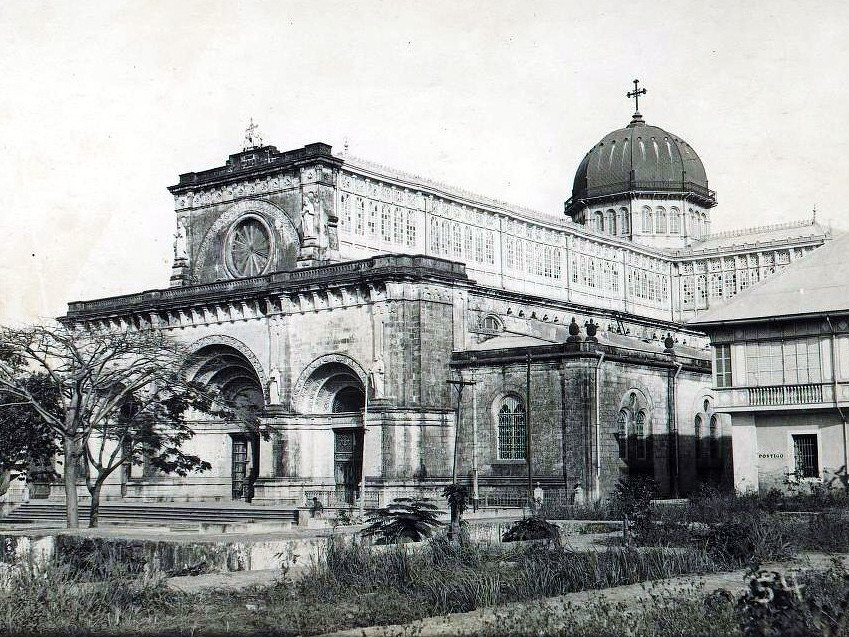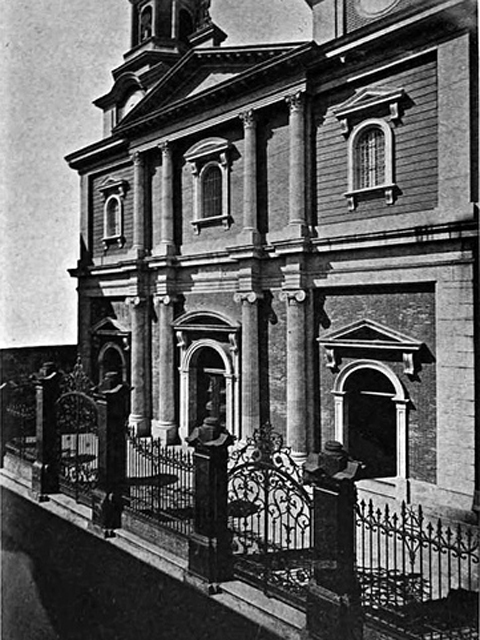Maybe a revival of piety (using the term in its Latin sense) will in the future inspire the return to Intramuros of all its former churches, chapels, convents and beaterios. Only then will Intramuros be really "restored". -Nick Joaquin
The Old Manila that was Intramuros was not only the economic and military center of the Spanish Empire in the far east. It was also the bastion of its strong Christian Faith. There used to stand, within the walls of Intramuros, seven houses of God, all built with architectural magnificence.
I've been always dreaming that one day, all the other 5 churches of Intramuros would rise again from the rubble. If you will visit the Walled City right now, you'll notice that only 2 of the original 7 churches managed to endure the test of time. Ask me what happened to the other 5 and I will answer you with a deep regretful sigh. What happened after the war was that our government focused on building new establishments over the rubble of the past glorious city, a mistake that put Manila's former beauty into a chaotic bustling city. Forever I will be unhappy that our post-war government chose development rather than restoration.
To repeat, Intramuros was the conjunto, of all its traditional temples; without its other colleagues, even the Cathedral and San Agustin are merely crown jewels without a crown. -Nick JoaquinWhat remained from the Seven Churches of Intramuros are the San Agustin Church (the only building left standing after the Liberation of Manila in 1945; listed as a UNESCO World Heritage Site) and the Manila Cathedral (rebuilt from 1953-1958). The other five no longer exist within the walls of Intramuros, the San Ignacio Church was left in ruins until now and the other 4 have new establishments built on their site.
1. Manila Cathedral
The ecclesiastical seat of the Archdiocese of Manila. Catastrophic events such as fire, earthquake and war have caused this structure to be reconstructed eight times on the same site (the last was completed in 1958 after its total destruction by the Liberation of Manila in 1945). The cross on its central dome was the zero kilometer reference point for all locations in the Philippines during the Spanish era (the reference point is now located at the Independence flagpole in Rizal Park). On its crypt lies the remains of former Archbishops of Manila including Cardinal Santos and Cardinal Sin.
 |
| Pre-war photo of the Manila Cathedral. [Photo Credits: http://www.skyscrapercity.com] |
 |
| The Manila Cathedral at present. |
2. San Agustin Church
Built by the Augustinians from 1587 and completed in 1604, it is considered to be the oldest stone church in the Philippines. Nothing remained standing inside the walled city except the Church of San Agustin after the Liberation of Manila in 1945. The church was spared from the bombings because it's bell tower was marked with a Red Cross (in times of war, attacking any building/establishment/vehicle that carries an emblem of Red Cross is a great war crime). In 1994, it was declared a UNESCO World Heritage Site.
 |
| Pre-war photo of San Agustin Church. [Photo Credits: http://www.skyscrapercity.com] |
 |
| San Agustin Church at present. |
3. San Ignacio Church
The church (neo-classical in style with two towers) was built by the Jesuits in 1889. The famous Filipino sculptor Isabelo Tampingco and his students worked on the lavish woodwork on its interior. However, it was greatly destroyed during the war and was left in ruins to date. At one time it became the E.J. Neil warehouse. Currently, there is an archaeological excavation at the site of its ruins, it is said that San Ignacio Church will be the future site of Museo de Intramuros that will house the religious collection of Intramuros Administration.
 |
| Pre-war photo of San Ignacio Church. [Photo Credits: http://www.skyscrapercity.com] |
 |
| At the back of the ruins of San Ignacio Church. |
 |
| Archaeological excavation site inside the walls of the ruins of San Ignacio Church. |
4. Lourdes Church
House of the Franciscan Capuchin friars built in 1891. It houses the allegedly miraculous statue of the Our Lady of Lourdes, carved by Manuel Flores in 1892. The war also destroyed the church in 1945, forcing the Capuchins to move to its current location in Retiro, Quezon City. This site is now occupied by El Amanecer compound where the Ilustrado Restaurant and Silahis antique shop is located.
 |
| Pre-war photo of Lourdes Church. [Photo Credits: http://www.skyscrapercity.com] |
 |
| The old site of the Lourdes Church. Now site of Silahis Souvenir Shop. |
5. Recoletos Church
The church that was famous for its four-story bell tower and its magnificent interior. Was built several times from 1619 (the last was built in 1782). It was in this church that Father Diego Cera, the man behind the construction of the Las Pinas Bamboo Organ, started making organs made of bamboos. The Recollect friars moved to San Sebastian Church in Quiapo after the war severely destroyed their church in Intramuros. Manilla Bulletin now occupies the site.
 |
| Pre-war photo of Recoletos Church. [Photo Credits: http://www.skyscrapercity.com] |
 |
| Old site of Recoletos Church. Now site of the Manila Bulletin Building. |
6. San Francisco Church
The church of the Franciscan Order (second to arrive in the country) first built in 1578. It was burned down in 1583 so a new stone church was built in 1602. The earthquake of 1645 destroyed again the church. The third church was built in 1738. It then had a retablo-like facade decorated with collumns, statues and niches. It remained in ruins after its destruction during the war. Mapua Institute of Technology rose from its rubble.
 |
| Pre-war photo of San Francisco Church. [Photo Credits: http://www.skyscrapercity.com] |
 |
| Old site of San Francisco Church. now site of Mapua Institute of Technology. |
7. Santo Domingo Church
The Dominicans built five churches on the same site, the last (built in 1868) was designed by Felix Roxas Sr. in Neo-Gothic style. The church was famous for its ivory image of Our Lady of the Most Holy Rosary (Nuestra Senora del Santisimo Rosario) also known as the Virgin of La Naval. It is believed that the Virgin Mary brought victory to Spanish fleet over the invading Dutch, hence the feast of La Naval is celebrated annually every 7th of October. When the Japanese burned down the church in 1941, the Dominicans moved to its current site in Quezon City. The site is now occupied by the Bank of the Philippines Islands.
 |
| Pre-war photo of Sto. Domingo Church. [Photo Credits: http://www.skyscrapercity.com] |
 | |||
| Old site of Sto. Domingo Church. Now site of BPI building. |
Ivan Briñas Cultura, 19, a biology student with an adventurer's instinct and a little introverted personality. He is a history lover and a wannabe photographer. He's a pure Filipino from Manila who dreams to have M.D. after his name. Though his ultimate goal in life is to have his name in Philippines' history. Solo traveling, photography, locating historic markers and watching musicals are his favorite pastime.
Visit his blog here.
Visit his blog here.


ang bilis naman. haha. thanks for this Mark.
ReplyDeleteNo, dude! THANK YOU! Yes. Kailangan mabilis kasi kailangan na itong malaman ng lahat. Hahaha! Salamat! This is a woderful post. :)
ReplyDeleteI never would’ve thought about it this way unless it runs into your blog. Thanks for putting it up. I hope you have great success.
ReplyDeleteCondo Price Singapore